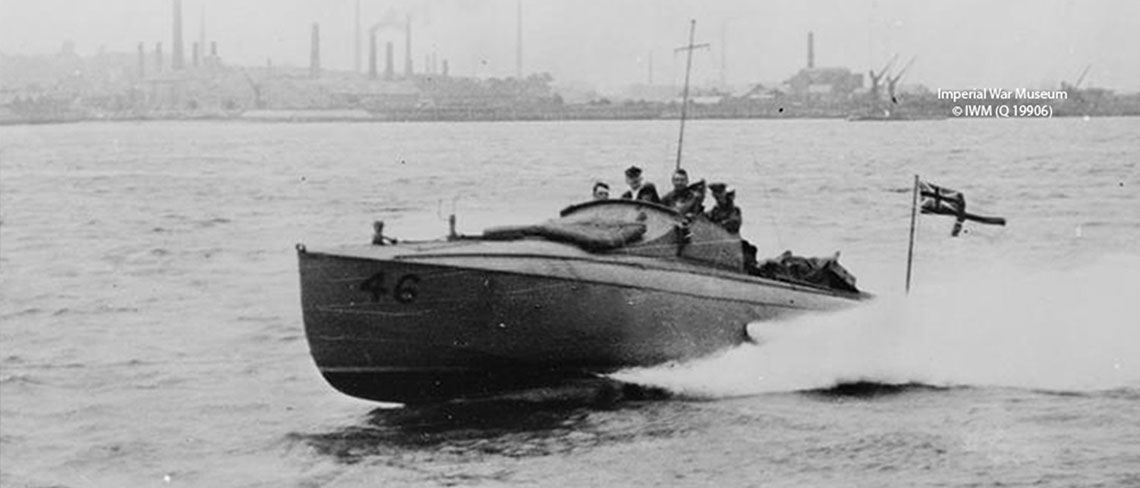

Six years in the making:
Portsmouth Naval Base Property Trust and a team of volunteers have successfully built a working replica of “CMB4”, the famed naval craft that sank the Russian warship “Oleg” in 1919
- Original CMB4 was designed in part by one of the first female members of what is now the Royal Institution of Naval Architects and commanded by naval hero Lieutenant Augustus Agar
- Contributions from the Imperial War Museum and National Maritime Museum were crucial to successfully carrying out century-old boat building methods
- Launch event at Boathouse 4 in Portsmouth Historic Dockyard being held today (September 8), where CMB4R will be seen on the water for the first time
- Volunteers in the replica project include relatives of those directly connected to the original CMBs
Speedy and lethal WWI naval vessel, Coastal Motor Boat 4 is today (8 September) taking to the Solent in the form of a fully active and meticulously built replica, CMB4R (R for replica), thanks to six years of research and hard graft by a team of 35 dedicated volunteers and partners of the Portsmouth Naval Base Property Trust (PNBPT).
100 years since a coastal motor boat was last active, visitors to Boathouse 4 in Portsmouth Historic Dockyard will marvel at CMB4R, aka the “Spitfire of the Sea”, following a private launch event hosted today by the PNBPT, custodians of the Dockyard estate.
Designed in part by one of the first female members of the Royal Institute of Naval Architects and famed for sinking the Oleg, a Russian warship, in 1919, CMB4 and its creation tells one of the great stories of innovation and design in naval history.
Visitors to the Dockyard will be soon able to ride alongside CMB4R in MGB81, one of the Trust’s existing vessels to witness it in action. Anyone interested in booking a charter, should email [email protected].
CEO of the Trust, Hannah Prowse, said: “This replica is the brainchild of Rodney Agar, nephew of the original CMB4’s most famed commander, Lieutenant Augustus Agar. Thanks to funding secured from the Chancellor’s LIBOR fund in 2016, we were able to make Rodney’s ambitious dream a reality despite boat building of this nature being now no longer widely practiced or documented.
“The influence of the CMB on naval architecture post-WWI is of such significance, it felt only right to recreate this revolutionary vessel so visitors to Portsmouth Historic Dockyard could appreciate and understand its impact.
“We must pay tribute to our wonderful team of volunteers led over the years by David Griffiths, Bob Forsyth and Diggory Rose, our partners Landau, as well as the National Maritime Museum, who provided the crucial plans of the original Coastal Motor Boat from 1915, without which they wouldn’t have been able to build such a high quality replica.
“A great amount of thanks also to the Imperial War Museum, who loaned us the original CMB4 currently on display in Boathouse 4, which was integral to helping the team understand the boat’s engineering.”
Pioneer in naval architecture – Blanche Thornycroft
The CMB was designed in 1915 by The Thornycroft Company, a shipbuilder experienced in designing, building and racing high speed boats in the years before the first World War.
Owner, Sir John Isaac Thornycroft and his children, John Edward, Tom and daughter Blanche all contributed to the design of the CMB.
Despite being one of the first three women to be admitted to the Royal Institution of Naval Architects in 1919, it’s only recently that Blanche has begun to receive recognition for her contribution to naval engineering.
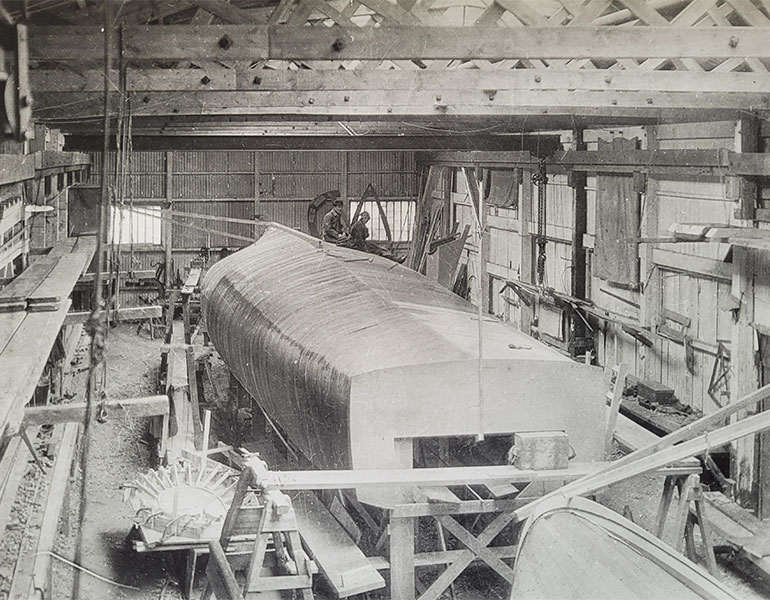
Blanche and Tom Thornycroft sitting on top of an original CMB at Platt’s Eyot in London
Hamo Thornycroft, a former civil architect, marine draftsman and marine photographer is great nephew to Blanche and has been a part of the CMB4R team for almost a year.
Hamo said: “It’s only in the last four or five years that historians have become more interested in Blanche and her influence on naval engineering. I don’t think her impact on other women working in or aspiring to work in boat engineering can be underestimated, but I still think there’s more to be done in the industry. The way to move forward is to employ the best brains and women sure have a lot of them!”
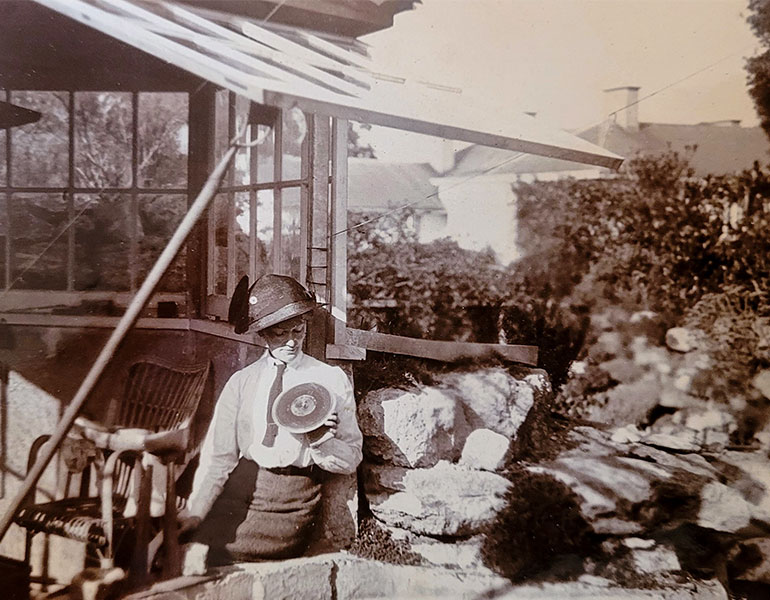
Blanche Thornycroft holding a recording disc used to test model boats at Steyne House on the Isle of Wight, the Thornycroft family home
Spitfire of the Sea
At 40 feet long, the CMB is one of the most lethal small vessels used by the Navy during WWI. Its stepped hull was a revolutionary design feature that allowed it to reach impressive top speeds of nearly 40 knots (approx. 46 mph); a truly eyebrow-raising speed at the time of its inception, allowing it to slip by enemy defences. Such was its significance, sea trials for the CMB were held at night in order to keep it a secret from enemy agents.
Equipped with torpedoes, speed and agility, the CMB made for a highly efficient attack boat during WWI and beyond, influencing high-speed boat design across the world, including the much larger and widely-used gunboat; a staple vessel in naval history. Made of wood, the CMB had limited defences against enemy fire, making the crew among the bravest in the Royal Navy at the time.
Steeped in Naval History
Naval hero and recipient of the Victorian Cross – the highest and most prestigious British military honour – Lieutenant Augustus Agar is one of the most famed naval officers to have been at the helm of a CMB.
At the end of the First World War, Britain was engaged in the Russian War of Independence, fighting the Bolsheviks on behalf of the White Russians. In June 1919, CMBs led by Lieutenant Agar were working for the Secret Intelligence Service (SIS, now known as MI6), and were tasked with ferrying messages and couriers in and out of St Petersburg.
That same month, CMB4 famously sank a 7,000-ton Russian cruiser (Oleg) – over 1,500 times its weight – with a single torpedo in a daring solo mission led by Lieutenant Agar, shortly after his SIS assignment.
Two months later, CMB4 and Lieutenant Agar were involved in the famous “Raid on Kronstadt”, in which eight CMBs and 12 Royal Air Force aircraft attacked the Bolshevik Baltic fleet. A Russian submarine depot ship was sunk and a battleship and destroyer were badly damaged.
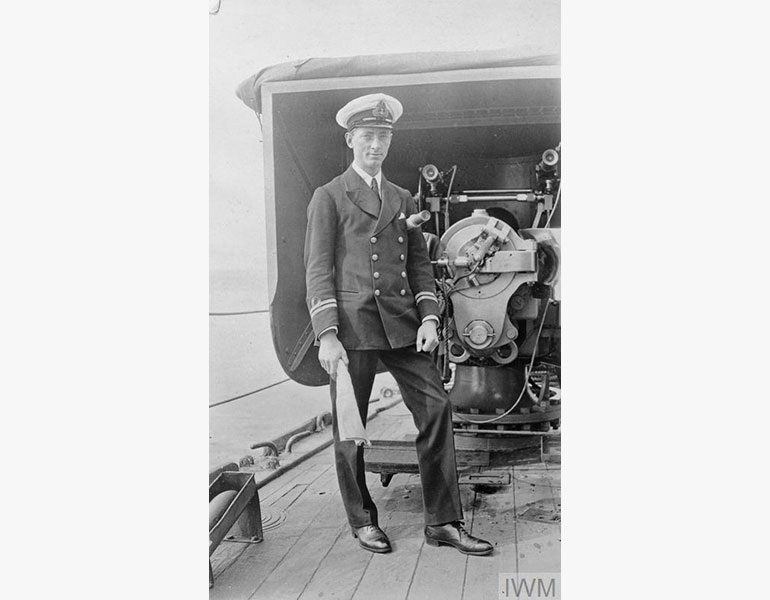
Lieutenant Augustus Agar (image property of Imperial War Museum)
The Build
Building a replica of a 100-year old boat is certainly not without its challenges, even for the most talented shipwrights. However, Boathouse 4’s dedicated team of volunteers successfully built CMB4R with great craftmanship, hard work and one vital piece of history.
Shipwright David Griffiths said: “The team have predominately used traditional boat building methods on CMB4R. War boats from this era were not built to last – they had pretty short life expectancy, as you can imagine.
“CMB4R is meant to look the part but is finished using 21st century technology to better preserve it for future generations.”

CMB4R built by volunteers in Portsmouth Historic Dockyard
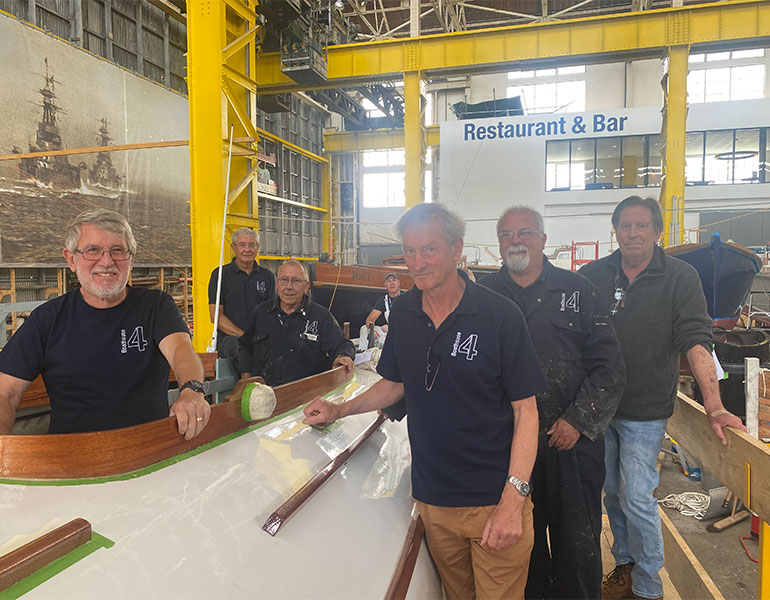
(From right to left) Team lead David Griffiths and volunteers Mike Scott, Hamo Thornycroft, Tim Deacon, Mike Finch and Steve Dawson with CMB4R
For more information visit: pnbpropertytrust.org or head to Boathouse 4 at the Portsmouth Historic Dockyard.
To find out more on how to book a charter to see CMB4R in action, email [email protected].
-Ends-
Notes to Editors:
Available for interviews in the lead up to, and at the official launch event on Friday 8 September, are:
– Hannah Prowse, CEO of Portsmouth Naval Base Property Trust
– Hamo Thornycroft, volunteer and great nephew of Blanche Thornycroft
– Rodney Agar, nephew of Lieutenant Augustus Agar
– David Griffiths, volunteer team lead
For further press information & interviews contact:
Yasmine Triana | Dylan Smart | Isaac Parry
Rooster.
T: +44 (0)203 440 8930 | +44 (0)7568 429 827
E: [email protected]
About Portsmouth Naval Base Property Trust:
Portsmouth Naval Base Property Trust (PNBPT), a charitable organisation, was established in 1986 by the Ministry of Defence and English Heritage, and encompasses the 12 acre Portsmouth Historic Dockyard estate.
As guardians and custodians of the estate, the Trust is responsible for the conservation and sustainable restoration of buildings, boats, and structures of outstanding architectural and historic interest, repurposed and made accessible for the use and enjoyment of future generations.
A destination of national importance, the estate is home to iconic historic landmarks and educational attractions, including the National Museum of the Royal Navy, HMS Victory and HMS Warrior, and the world-class Mary Rose Museum.
The Historic Dockyard sits alongside the operational Naval Base with its 21st century aircraft carriers and supporting fleet, creating a vibrant, immersive, educational and inspiring must-visit place.
To find out more, visit: https://www.pnbpropertytrust.org/






